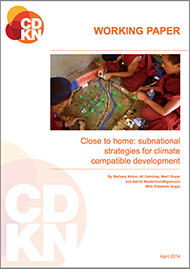Close to home: subnational strategies for climate compatible development


Executive Summary
The battle for climate compatible development will be won or lost at the subnational level: in provinces, districts and cities. National governments depend on subnational actors to implement climate policies. What is more, innovation in climate compatible development can flourish at the subnational level when the appropriate legal and policy conditions are created.
Climate compatible development at the subnational level is characterised by distinct challenges:
- Subnational institutions and leaders face intense local pressure to act on the negative impacts of climate extremes and disasters.
- People’s expectations for subnational authorities to respond may be out of sync with the powers and resources they have available.
- Higher levels of scientific uncertainty about future climate trends at the local level (than at larger scale) can make it difficult to know if investments are ‘climate-proof’.
- Different subnational governments and agencies may struggle to coordinate with each other, making it harder to respond effectively to climate change and forge long-term solutions.
- The scale and pace of urbanisation in many developing countries, including unplanned settlements and the informal economy, magnify these challenges.
Subnational actors also have particular opportunities to pursue climate compatible development:
- Subnational actors often have a sound understanding of climate trends in their area, based on first-hand experience and local and indigenous knowledge.
- Subnational decision-makers have a better sense than national decision-makers of solutions that are effective in the local context. They also know how to communicate the case for action effectively to local stakeholders.
- Subnational actors have greater ability to mobilise local resources for implementation, including people’s time and knowledge.
- Integrating climate and development approaches requires a great deal of coordination among individuals and institutions, but it is exactly at the subnational level that such examples of integration across sectors is likely to happen, and can lead the way for integration at higher levels of governance.
Effective strategies for subnational climate compatible development respond to these challenges and build on these opportunities. Such strategies:
- Use flexible modes of decision-making available at the subnational level to go beyond national mandates for climate compatible development and innovate solutions.
- Raise the awareness of climate ‘champions’ in subnational government and bolster their climate leadership.
- Build a strong case for action through effective, locally relevant communications about climate change impacts and the benefits of low-carbon, climate-resilient development.
- Mobilise local expertise and support including in-kind resources, and forge alliances among civil society, businesses, researchers (including climate scientists), government decision-makers and civil servants.
- Secure additional resources from outside the locality where necessary.
CDKN’s and ICLEI’s experience demonstrates that these strategies yield good results at the subnational level. However, the scale of the global climate challenge is huge. Alone, individual subnational initiatives do not achieve enough. It will take a global transformation in the way that society approaches development if we are to achieve a low-carbon, climate-resilient future. Successful subnational climate compatible strategies must be rapidly scaled up and scaled out to meet this challenge.
Suggested citation
Anton, B., Cambray, A., Dupar, M., Westerlind-Wigstroem, A., Gogoi, E., 2014. Close to home: subnational strategies for climate compatible development. CDKN.
(0) Comments
There is no content